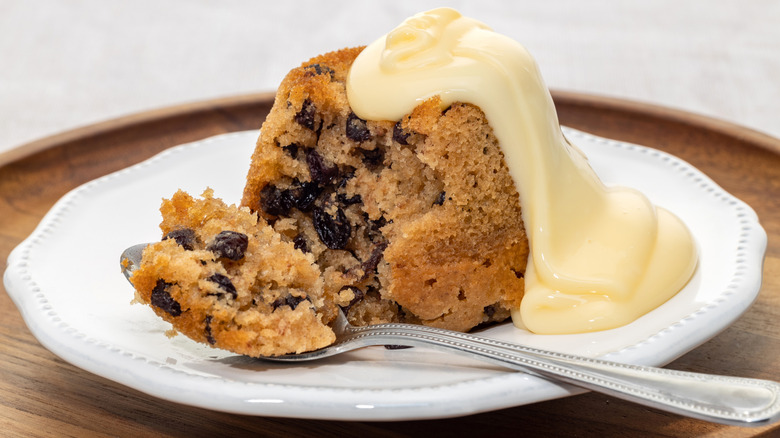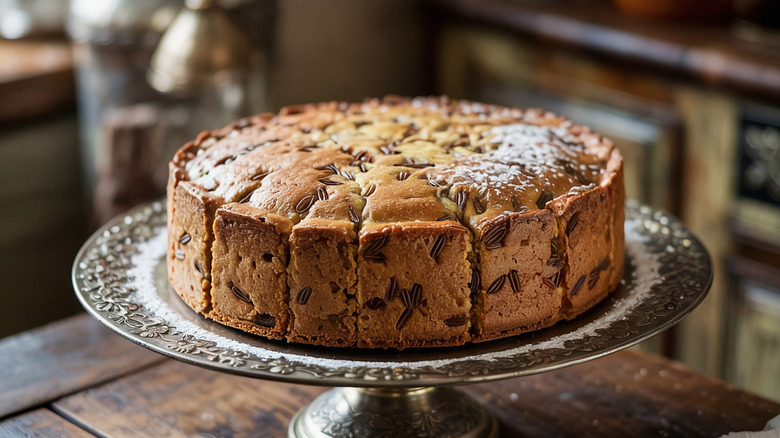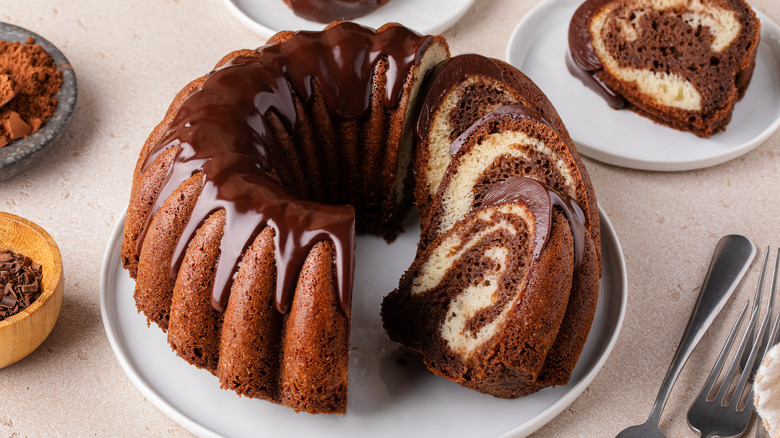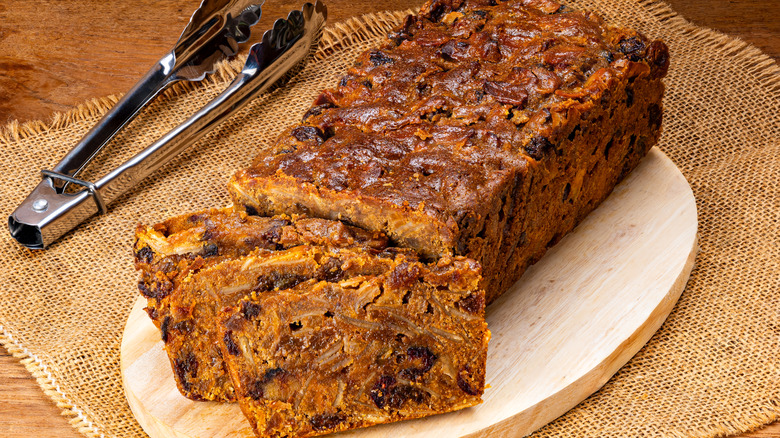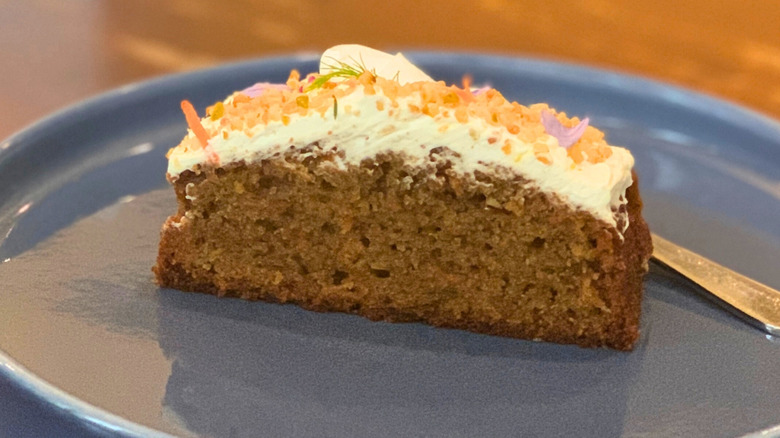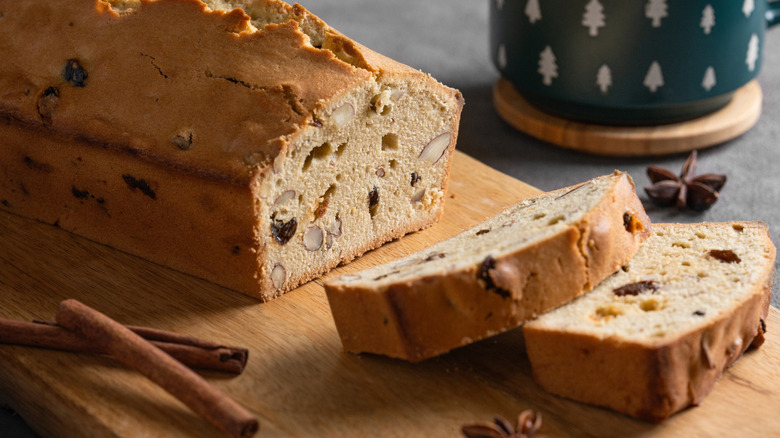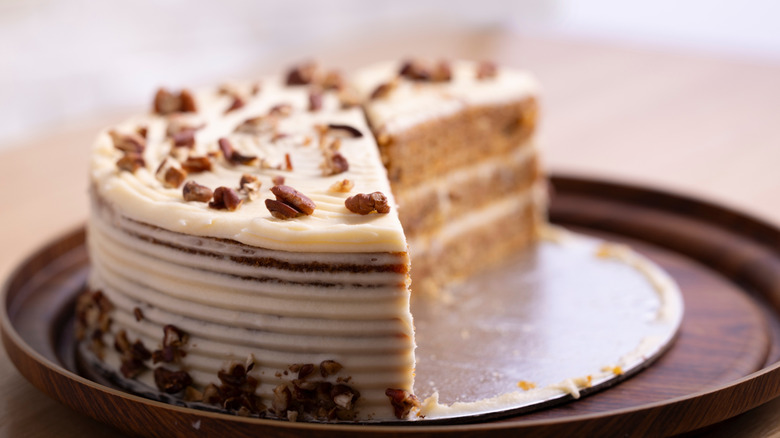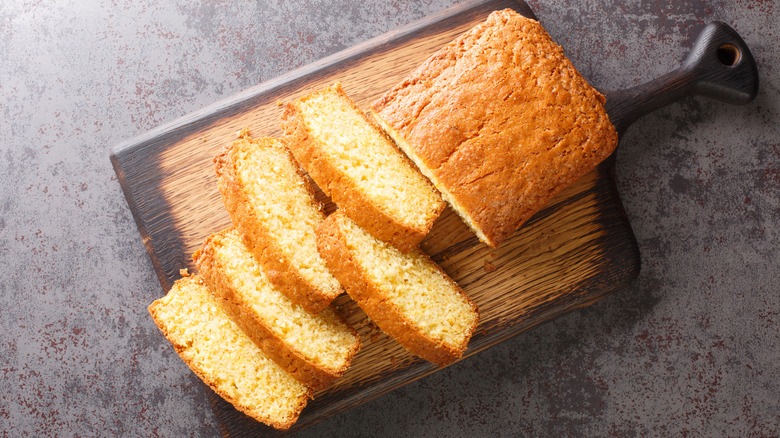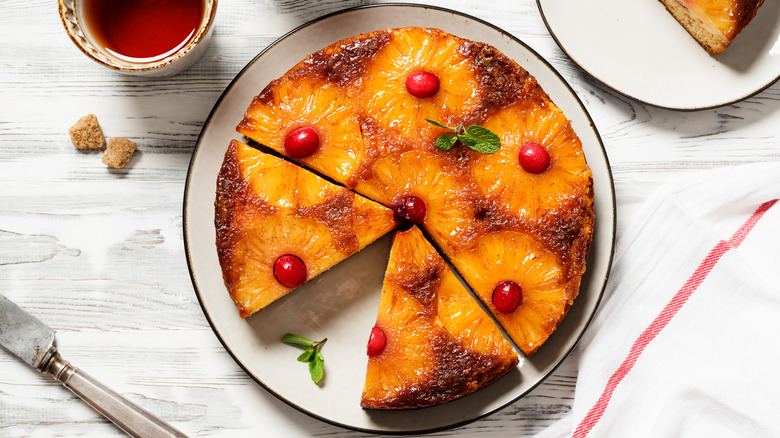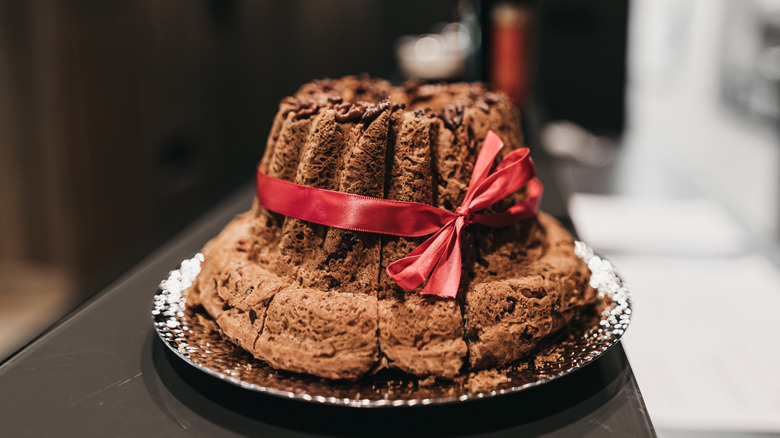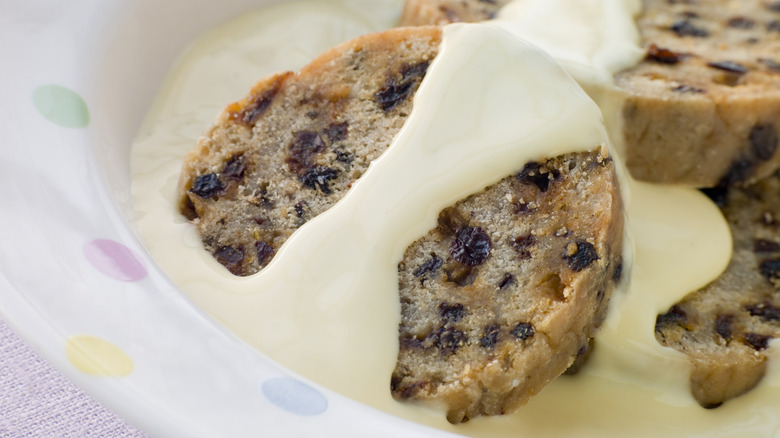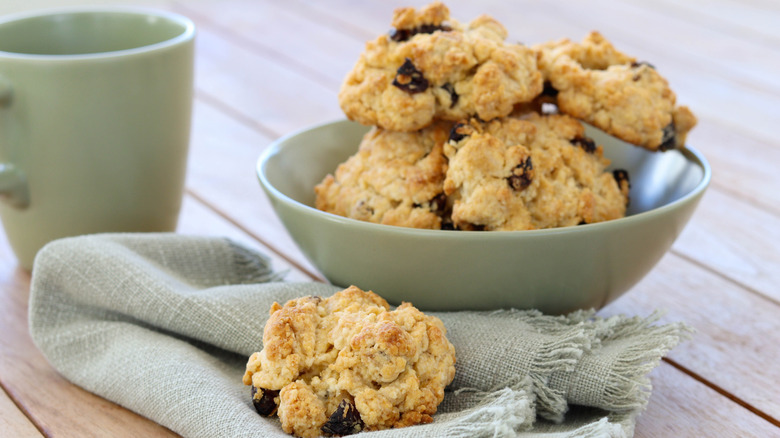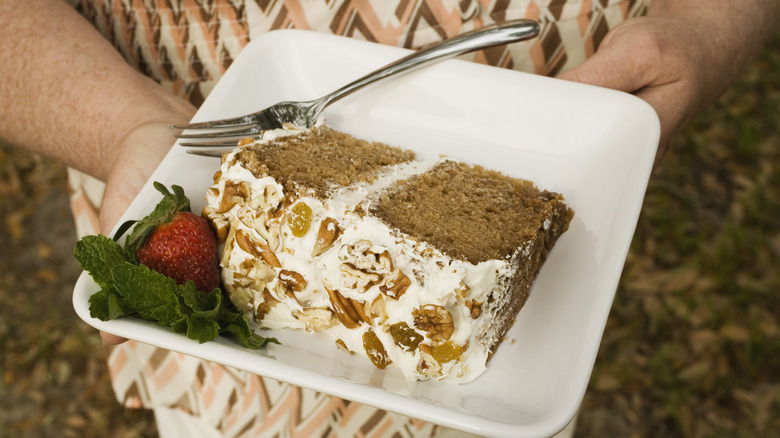Old School Cakes Nobody Eats Anymore
Cake has a long history — perhaps thousands of years — although modern cakes are quite different from archaic ones, which were often more like sweet breads. It might have been around for ages, but it's a sweet treat that goes through trends, which is why you'll find some old-school cakes that nobody eats anymore. Some might be totally resigned to the annals of history, whereas others have fallen out of favor and are unfashionable, but you might still occasionally find them on your great aunt's dinner table.
We're about to explore some of these lesser-known and abandoned cakes to learn what they're all about and, in some cases, why they're no longer quite as popular. Whether you're looking to make some cakes from the past or you're just curious about baked goods through the ages, you're in the right place. You can learn something and maybe work up an appetite at the same time. Here are 13 historic or old-fashioned cakes that have fallen out of favor.
1. Seed cake
Seed cake doesn't have the instant name recognition of Victoria sponge or Battenberg. In fact, it's totally fallen out of favor, despite having been part of British food culture for centuries. It's a rich, buttery loaf cake, but where it differs is the titular seeds. It's flavored with caraway seeds, which give it a faint licorice or anise flavor.
Its history goes back much further than you might expect. Seed cake has been around since the medieval times, though it may have been different back then. It maintained a steady popularity over the years, cropping up in domestic cookbooks and household ledgers. It was popular during the Georgian and Victorian eras. References show up in classic literature, including "Jane Eyre" and "David Copperfield."
While it's not common today, seed cake still shows up at heritage fairs and in older cookbooks. If you like Madeira cake but wish it had a little more personality, seed cake might be your new favorite. The flavor can take some getting used to — and maybe that's why you don't see it in every coffee shop and bakery — but you never know, you might love it.
2. Marble cake
Marble cake was once a fixture at bake sales, birthday parties, and potlucks across the nation. It was the kind of cake that felt fancy without trying too hard. It's made by swirling together two batters, usually vanilla and chocolate, to create a marbled effect when sliced. Yes, the cool patterns were part of the appeal but flavor was also a big factor: you didn't have to choose between chocolate or plain. You got both.
Its roots go back to 19th-century Germany, and it became popular in the U.S. not long after, thanks to German immigrants who brought the technique with them. For decades, it was a go-to recipe for many, a reliable middle-of-the-road crowd-pleaser. That's not to insult the simple pleasures of this cake, but just to say it was there doing its thing, not being too showy.
So, why don't we see it much anymore? It might be too subtle for today's dessert trends. There's no gooey center, no molten filling, no intense frosting. It's also easy to get wrong, making it too dry, too bland, or with not enough contrast between the two batters. But when it's done well, it's still a classic. So, it might be time to big out that old marble cake recipe your grandma used to make.
3. Boiled fruit cake
You might have a favorite fruit cake recipe, but we bet it isn't a boiled version. Boiled fruit cake isn't winning any popularity contests these days, but it was once a practical staple in British home baking. Now, it might sound like the cake itself is boiled but this isn't the case. It's actually the fruit that's boiled, often with booze, butter, and sugar. The result is dense and dark, somewhere between a tea loaf and a Christmas cake — only quicker, cheaper, and less fussy.
This was the kind of cake people made when they wanted something that felt generous but didn't require fancy ingredients or hours in the oven. You could throw it together with what you had in the cupboard: a bit of dried fruit, some margarine, and maybe a splash of cold tea. Boiling the fruit softened it and gave the cake a rich, treacly flavor without needing weeks to mature.
It's rarely seen now outside of charity cake stalls or church fêtes, but boiled fruit cake still holds its own if you're after something sturdy, not too sweet, and full of raisins. It's the kind of cake that slices cleanly, keeps for ages, and gets better after a few days in the tin.
4. Tomato soup cake
A tomato soup cake is exactly what it sounds like — a cake that's got a can of soup mixed in. But why, exactly? Well, it might not surprise you but tomato soup cake has old timey origins. Precisely where it came from is unclear, but it seems to date back to World War II days and the Great Depression era.
Back then, food could be scarce with certain goods rationed. In soup recipes, a can of tomato soup was used in place of eggs and milk — fresh goods that could be difficult to get hold of. While the tang of tomato does come through, it isn't meant to be a tomato flavored cake. Rather, it's spiced with ingredients like cinnamon and nutmeg. This transforms it into a spice cake, but also helps to disguise the soup flavor. And to top it all off, you have cream cheese frosting.
While some people still consider it a nostalgic classic, it's not the kind of cake you encounter often. It's probably not on the menu at your favorite café, for instance. And, we get it. You might resort to putting soup in cake if you're lacking other ingredients... but most people prefer not putting soup in cake. And we're with them.
5. Yorkshire spice cake
Yorkshire is the county in England where this old-school cake originated. Unless you're from the region, you might not have even heard of it, as it's no longer popular outside of its place of origin. And that's a shame because Yorkshire spice cake is delicious.
It's usually baked as a loaf cake and uses mixed spice for flavoring. Common in the U.K. but not so much elsewhere, mixed spice is a blend of sweet spices. Recipes vary, but cinnamon is usually the main contender, with others like ginger and allspice having a lesser roll. In the U.S., the closest equivalent is pumpkin pie spice, or you could make your own spice blend.
It also contains raisins and currants and uses lard or dripping rather than butter. The other thing that sets it apart is its raising agent. It uses a combination of baking soda and vinegar to help it rise, doing so without eggs.
6. Lane cake
Lane cake feels more like folklore than food. It's a Southern classic passed down through battered recipe cards, mentioned in "To Kill a Mockingbird," and rarely seen outside of church suppers or state fair competitions. It's a layered white cake, often made with egg whites for a light crumb. However, the filling is really where it's at. It's a mix of egg yolks, butter, sugar, raisins, coconut, and pecans, often with bourbon or brandy for good measure.
It was invented by Emma Rylander Lane of Alabama in the late 1800s, and for a while, it was the go-to cake to bring to weddings or holidays in the South. The filling is cooked on the stove, which makes it more like a curd or custard than a frosting, and it's usually sandwiched between the layers with little or no icing on the outside. That said, some versions go all out with a snowy meringue or buttercream finish.
Lane cake has probably fallen out of favor because it's a bit of a project. With multiple components, a cooked filling, and a necessary resting time, it's not a casual weekend bake. But for those who do take it on, Lane cake still delivers. It's a slice of Southern history, sure, but it tastes great, too.
7. Madeira cake
Madeira cake is more antique than old-school. It first started appearing in recipe books around the 1840s. Some people assume this style of cake contains Madeira wine or comes from the island of Madeira. This isn't true — however, it got its name because it used to be fashionable to serve it alongside Madeira wine.
It's effectively just a simple sponge cake made from roughly equal quantities of butter, sugar, flour, and eggs, although they're not always identical as they are in a pound cake. It has less leavening agents than similar sponges, which gives it a slightly dense texture, rather than being light and fluffy. It isn't even flavored with vanilla, the way that most yellow cakes are. The fact that it's so plain might be part of the reason why it's fallen out of favor. Many people are drawn toward cakes with bold flavors and lots of frosting.
While we love an overblown cake, there is something to be said for the simplicity of Madeira cake, so you shouldn't discount it. Yes, basically nobody eats it anymore, but we're not quite sure why.
8. Pineapple upside down cake
Once the height of post-war glamour, pineapple upside down cake is the kind of dessert that feels frozen in time. Built on a layer of tinned pineapple rings and glacé cherries carefully arranged, this cake was all about showmanship with minimal effort. The base caramelizes in the oven, and when flipped out of the tin, it becomes a tasty topping.
It's been featured in American cookbooks since the 1930s. Well into the mid-century period, a good pineapple upside down cake was seen as modern and even refined. It made a neat centerpiece for coffee mornings and dinner parties, using canned food in a creative way.
While it's easy to dismiss now as a bit naff, there's something undeniably satisfying about the combination of syrupy fruit, soft sponge, and slightly crisp, caramelized edges. So, it might be time to crack out a pineapple upside down cake recipe to remind you that there's nothing wrong with a bit of kitsch.
9. Kugelhopf
You don't see kugelhopf much anymore, at least not outside of European bakeries or the occasional high-end patisserie. But for a long time, this towering, fluted cake was a symbol of celebration across central Europe, especially in Alsace, southern Germany, Austria, and Switzerland. It's a yeasted cake, more bread-like than sponge, which often contains raisins and sometimes almonds.
The American version, when it shows up at all, is usually sweet, but traditional kugelhopf leans more subtle than sugary. It's gently flavored, maybe with a splash of kirsch or orange blossom water, and best served plain, dusted with powdered sugar. It's the kind of thing you might have with a morning coffee or an afternoon glass of wine, rather than as a dessert drowned in frosting.
Kugelhopf was once a holiday staple, baked for weddings, feast days, and big family gatherings. Immigrants brought it to the U.S. in the 19th century, but it never quite took off the way other European bakes did. Blame the rise of sweeter, flashier cakes, or the fact that it requires a special tin and a bit of patience. Still, when done right, kugelhopf is light, buttery, and quietly elegant — old-school but not irrelevant.
10. Spotted dick
Perhaps more of a dessert than a cake, but definitely cake-adjacent, spotted dick is one of those foods with an unusual name. It might sound unappetizing, but it used to be a popular sweet treat in the U.K. It's now fallen out of favor, maybe somewhat because of the giggle-worthy name, but also due to changing tastes.
Spotted dick is a sponge pudding with raisins scattered throughout the dough. The raisins explain the "spotted" part of the name, but where the "dick" portion came from is less clear. It may have evolved from the word pudding over time. This sponge is often served with custard and used to be served in school canteens and traditional eateries all over the British Isles. Now, it's much less common and almost never seen out in the wild.
Is this a loss to the world? It's hard to say. For anyone who likes dense cakey sponges and dried fruit, you probably are missing out. But many people today instead reach for flavors like chocolate, vanilla, salted caramel, or lemon. Anything a bit punchier than a plain sponge and raisins. It might be better to remain a relic of the past with a name we look back on and laugh.
11. Rout cake
Rout cake isn't just old-school, it's archaic. The recipe dates all the way back to the Regency era of 19th century England although these cakes were still popular in Victorian times. Named for the elegant evening parties or "routs" that were all the rage in early 19th-century England, this cake was the kind of thing you'd nibble with a cup of tea in one hand and a fan in the other.
It was closer to a biscuit or a tea cake than a modern day sponge. They consist of a basic dough of flour, sugar, butter, and egg, with dried fruit mixed throughout. Flavoring varied but could be alcohol, rosewater, or orange blossom water. Perhaps the closest modern relative is a rock cake. While they were often made into small individual cakes, they could also be made as one large cake for slicing and sharing.
You almost never see rout cake anymore, possibly because it doesn't fit into modern baking categories or suit modern tastes. However, they stay alive through the many historic recipes available and through those people who like to make them.
12. Lady Baltimore cake
Lady Baltimore cake sounds about as fancy as it is. It's a refined Southern layer cake with a filling made from chopped figs, raisins, and nuts folded into a thick, sugary meringue or boiled frosting. The whole thing is usually iced with more of the same fluffy meringue-like frosting, without the added fruits and nuts.
It first gained popularity in the early 1900s, thanks in part to a novel by Owen Wister called "Lady Baltimore," in which the narrator orders a Lady Baltimore wedding cake. According to the author, this fictional cake was inspired by a real one, which he used to buy from the Lady Baltimore Tea Room. It was supposedly developed by the owners, Florence and Nina Ottelengui, and was a variation of the queen cake.
So, why don't we see it anymore? For one, it's fussy. The frosting is boiled, the egg whites need beating, and there's a lot of faffing around with the dried fruit and nuts. For lots of people, it's just not a feasible cake to bake. But for those willing to make the effort, Lady Baltimore cake is still a showstopper.
13. Wacky cake
Wacky cake is a slice of baking history. It was born out of necessity in the World War II era when ingredients like eggs, butter, and milk were scarce due to rationing. It's a one-bowl chocolate cake that skips all three and somehow still manages to come out delicious.
The method is part of the charm. You mix the dry ingredients right in the pan, make three little wells — one for vinegar, one for oil, and one for vanilla — then pour water over the top and stir. It comes together ridiculously easily, and with no eggs and dairy, making it accidentally vegan. It just takes a handful of pantry staples and a bit of baking alchemy.
Despite how easy and dependable it is, wacky cake doesn't get much love these days. Maybe it's because people associate it with hardship, or maybe the simplicity just doesn't stand out. But it deserves a comeback. It's a reminder that great cake doesn't always require a full fridge or a stand mixer. All you need is a wooden spoon and a bit of baking know-how.
